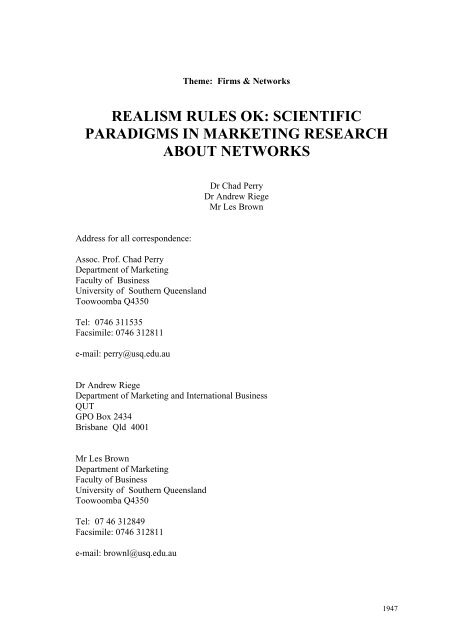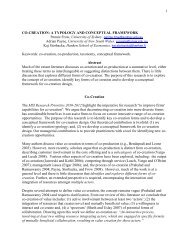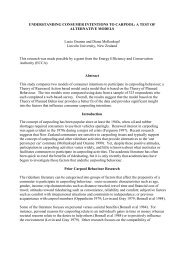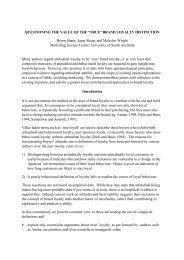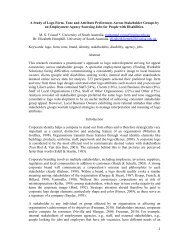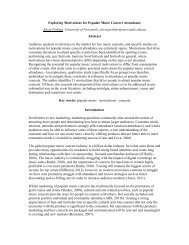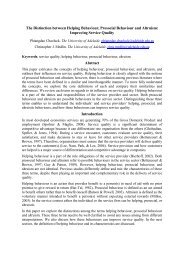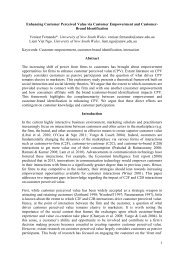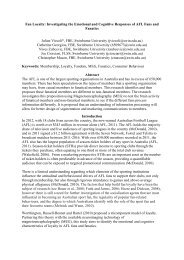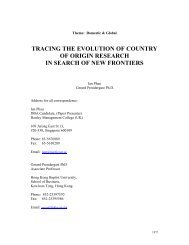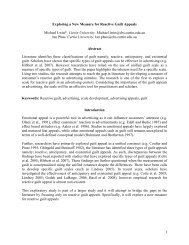realism rules ok: scientific paradigms in marketing ... - ANZMAC
realism rules ok: scientific paradigms in marketing ... - ANZMAC
realism rules ok: scientific paradigms in marketing ... - ANZMAC
You also want an ePaper? Increase the reach of your titles
YUMPU automatically turns print PDFs into web optimized ePapers that Google loves.
Theme: Firms & Networks<br />
REALISM RULES OK: SCIENTIFIC<br />
PARADIGMS IN MARKETING RESEARCH<br />
ABOUT NETWORKS<br />
Address for all correspondence:<br />
Assoc. Prof. Chad Perry<br />
Department of Market<strong>in</strong>g<br />
Faculty of Bus<strong>in</strong>ess<br />
University of Southern Queensland<br />
Toowoomba Q4350<br />
Tel: 0746 311535<br />
Facsimile: 0746 312811<br />
e-mail: perry@usq.edu.au<br />
Dr Chad Perry<br />
Dr Andrew Riege<br />
Mr Les Brown<br />
Dr Andrew Riege<br />
Department of Market<strong>in</strong>g and International Bus<strong>in</strong>ess<br />
QUT<br />
GPO Box 2434<br />
Brisbane Qld 4001<br />
Mr Les Brown<br />
Department of Market<strong>in</strong>g<br />
Faculty of Bus<strong>in</strong>ess<br />
University of Southern Queensland<br />
Toowoomba Q4350<br />
Tel: 07 46 312849<br />
Facsimile: 0746 312811<br />
e-mail: brownl@usq.edu.au<br />
1947
REALISM RULES OK: SCIENTIFIC<br />
PARADIGMS IN MARKETING RESEARCH<br />
ABOUT NETWORKS<br />
ABSTRACT<br />
This paper addresses the issue of <strong>scientific</strong> <strong>paradigms</strong> <strong>in</strong> market<strong>in</strong>g research about<br />
networks. It beg<strong>in</strong>s with an overview of a ‘rapprochement’ model suggested for<br />
network research by Borch and Arthur (1995) which attempts to <strong>in</strong>tegrate both<br />
objective and subjective research. We argue that their two-dimensional approach could<br />
be extended to <strong>in</strong>clude the <strong>realism</strong> paradigm that separates the objective, positivist<br />
dimension and the subjective, <strong>in</strong>terpretive dimension. Characteristics of that paradigm<br />
are described and its appropriateness for case study research is established.<br />
Key words: bus<strong>in</strong>ess networks, <strong>scientific</strong> <strong>paradigms</strong>, <strong>realism</strong><br />
1948
INTRODUCTION<br />
In recent years, research about bus<strong>in</strong>ess and market<strong>in</strong>g strategy has been criticised for<br />
not captur<strong>in</strong>g real-world complexity (for example, Pettigrew 1987). Borch and Arthur<br />
(1995) suggest that a mix of objectivist and subjectivist methodologies can help address<br />
criticisms like these. We suggest that the mix <strong>in</strong>volves more than methodological<br />
considerations - it <strong>in</strong>volves a reconsideration of all three aspects of <strong>scientific</strong> <strong>paradigms</strong><br />
used for market<strong>in</strong>g research.<br />
This paper has three sections. In the first section, the Borch and Arthur (1995)<br />
suggestion about methodologies is revisited. Then, four <strong>scientific</strong> <strong>paradigms</strong> are<br />
discussed <strong>in</strong> terms of ontology and epistemology, as well as methodology. Reasons why<br />
the <strong>realism</strong> paradigm is the most appropriate for some market<strong>in</strong>g research like that<br />
about networks, are then addressed. F<strong>in</strong>ally, the case study research methodology<br />
with<strong>in</strong> the <strong>realism</strong> paradigm is exam<strong>in</strong>ed.<br />
Borch and Arthur’s (1995) ‘Rapprochemont’ Methodology<br />
The objectivist approach is predicated on expla<strong>in</strong><strong>in</strong>g and predict<strong>in</strong>g phenomena, while<br />
the subjectivist approach emphasises describ<strong>in</strong>g and understand<strong>in</strong>g phenomena. Borch<br />
and Arthur (1995, p. 423) claim that both approaches should be used, argu<strong>in</strong>g a mixed<br />
methodology would “contribute to the richness of the new strategic management<br />
models”. Their bipolar approach to research is common, for example, Easterby-Smith,<br />
Thorpe and Lowe (1991) share it. In brief, their methodology aims to blend the rigour<br />
of the <strong>scientific</strong> validity of objectivist research with the contextual elements and<br />
<strong>in</strong>sights of subjectivist research (Borch and Arthur 1995, p. 425).<br />
We suggest that their blend of two approaches could be replaced with one approach, the<br />
third approach of <strong>realism</strong>. This third approach <strong>in</strong>volves a reconsideration of all three<br />
elements of <strong>scientific</strong> <strong>paradigms</strong> - ontology, epistemology and methodology - and not<br />
just methodology. This issue of <strong>scientific</strong> <strong>paradigms</strong> is addressed next.<br />
The Four Scientific Paradigms<br />
Researchers operate with<strong>in</strong> a <strong>scientific</strong> paradigm that is either explicit or implicit. A<br />
paradigm is an overall conceptual framework with<strong>in</strong> which a researcher may work, that<br />
is, a paradigm can be regarded as the “basic belief system or worldview that guides the<br />
<strong>in</strong>vestigator” (Guba and L<strong>in</strong>coln 1994, p. 105). Philosophical assumptions which<br />
support the four different <strong>paradigms</strong> of social science relat<strong>in</strong>g to ontology,<br />
epistemology and methodology are summarised <strong>in</strong> Table 1. In effect Table 1<br />
summarises the follow<strong>in</strong>g discussion.<br />
1949
Table 1 Basic belief systems of alternative <strong>in</strong>quiry <strong>paradigms</strong><br />
Paradigm<br />
Item Positivism Realism Critical theory Constructivism<br />
Ontology naïve critical <strong>realism</strong>: historical <strong>realism</strong>: critical<br />
<strong>realism</strong>: reality is “real” but “virtual” reality relativism:<br />
reality is real only imperfectly shaped by social, multiple local and<br />
and<br />
and<br />
economic, ethnic, specific<br />
apprehensible probabilistically political, cultural, “constructed”<br />
apprehensible and and gender values, realities<br />
so triangulation crystallised over<br />
from many sources time<br />
is required to try to<br />
know it<br />
Epistemology objectivist:<br />
f<strong>in</strong>d<strong>in</strong>gs true modified<br />
subjectivist: subjectivist:<br />
objectivist: value mediated created f<strong>in</strong>d<strong>in</strong>gs<br />
f<strong>in</strong>d<strong>in</strong>gs probably f<strong>in</strong>d<strong>in</strong>gs<br />
true<br />
Methodology experiments/ case<br />
dialogic/dialectical: hermeneutical /<br />
surveys: studies/convergent researcher is a dialectical:<br />
verification <strong>in</strong>terview<strong>in</strong>g: “transformative researcher is a<br />
of<br />
triangulation, <strong>in</strong>tellectual” who “passionate<br />
hypotheses: <strong>in</strong>terpretation of changes the social participant”<br />
chiefly research issues by world with<strong>in</strong> which with<strong>in</strong> the world<br />
quantitative qualitative and participants live be<strong>in</strong>g <strong>in</strong>vestigated<br />
methods quantitative<br />
methods such as<br />
structural equation<br />
model<strong>in</strong>g<br />
Note: Essentially, ontology is 'reality', epistemology is the relationship between that reality and<br />
the researcher and methodology is the technique used by the researcher to discover that reality.<br />
Source: Perry, Alizadeh and Riege, (1996, p. 547) based on Guba and L<strong>in</strong>coln (1994).<br />
Positivism. Positivists assume that natural and social sciences measure <strong>in</strong>dependent<br />
facts about a s<strong>in</strong>gle apprehensible reality composed of discrete elements whose nature<br />
can be known and categorised (Guba and L<strong>in</strong>coln 1994; Tsoukas 1989). The objectives<br />
of the research <strong>in</strong>quiry often <strong>in</strong>clude the measurement and analysis of causal<br />
relationships between variables that are consistent across time and context. The<br />
primary data collection techniques <strong>in</strong>clude controlled experiments and sample surveys<br />
which are outcome oriented and assume natural laws and mechanisms, with the primary<br />
mode of the research <strong>in</strong>quiry be<strong>in</strong>g theory-test<strong>in</strong>g or deduction. Data is usually<br />
collected <strong>in</strong> a structured manner with the researcher not <strong>in</strong>terven<strong>in</strong>g <strong>in</strong> the phenomenon<br />
of <strong>in</strong>terest and seek<strong>in</strong>g for theory test<strong>in</strong>g <strong>in</strong> value-free or hopefully value-free<br />
generalisations. In other words, the data and its analysis are value-free and data does<br />
not change because they are be<strong>in</strong>g observed. That is, researchers view the world<br />
through a ‘one way mirror’ (Guba and L<strong>in</strong>coln 1994, p. 110). Even <strong>in</strong> nuclear physics<br />
where particles cannot be directly observed, uncerta<strong>in</strong>ty <strong>in</strong> results is a methodological<br />
issue and not an ontological one - different observers us<strong>in</strong>g the same methodology<br />
should obta<strong>in</strong> similar results. All these assumptions of positivism are appropriate <strong>in</strong> a<br />
natural science, for example, every zoologist <strong>in</strong> the world will count the same number<br />
of bones <strong>in</strong> a dead k<strong>in</strong>gfisher.<br />
However, a positivist view is <strong>in</strong>appropriate when approach<strong>in</strong>g a social science<br />
phenomenon like networks which <strong>in</strong>volves humans and their real-life experiences, for<br />
1950
treat<strong>in</strong>g respondents as <strong>in</strong>dependent objects “ignores their ability to reflect on problem<br />
situations, and act upon this” (Robson 1993, p. 60). That is, positivists separate<br />
themselves from the world they study, while researchers with<strong>in</strong> the three other<br />
<strong>paradigms</strong> acknowledge that they have to participate <strong>in</strong> real-world life to some extent<br />
so as to better understand and express its emergent properties and features (Denz<strong>in</strong><br />
1983; Gilmore and Carson 1996).<br />
Furthermore, social science researchers should not seek to provide causal explanations<br />
with<strong>in</strong> a closed system as a positivist would. Instead, they should consider the complex<br />
nature of reality and the research problem, reflect<strong>in</strong>g, form<strong>in</strong>g and revis<strong>in</strong>g mean<strong>in</strong>gs<br />
and structures from managerial experiences and how these problems appear to<br />
managers (Orlikowski and Baroudi 1991). To approach this task, social science<br />
researchers could operate with<strong>in</strong> the non-positivist <strong>scientific</strong> <strong>paradigms</strong> <strong>in</strong>troduced next.<br />
Critical theory and constructivism. The second paradigm, critical theory, assumes<br />
apprehensive social realities, <strong>in</strong>corporat<strong>in</strong>g historically situated structures. Critical<br />
theory researchers aim at critiqu<strong>in</strong>g and transform<strong>in</strong>g social, political, cultural,<br />
economic, ethnic and gender values. Examples of critical theory researchers are<br />
Marxists, fem<strong>in</strong>ists and action researchers. Thus research <strong>in</strong>quiries are often long-term<br />
ethnographic and historical studies of organisational processes and structures.<br />
Assumptions are essentially subjective and hence knowledge is grounded <strong>in</strong> social and<br />
historical rout<strong>in</strong>es and is therefore value-dependent and not value-free (Guba and<br />
L<strong>in</strong>coln 1994).<br />
However, this paradigm is not appropriate for market<strong>in</strong>g research unless the researcher<br />
aims to be a “transformative <strong>in</strong>tellectual” who liberates people from their historical<br />
mental, emotional and social structures (Guba and L<strong>in</strong>coln 1994, p. 112). For example,<br />
most bus<strong>in</strong>ess network research aims at understand<strong>in</strong>g the actions of the decisionmakers<br />
rather than chang<strong>in</strong>g them or their approaches to strategy formulation.<br />
The third paradigm, constructivism, adopts a relativism ontology. An example of a<br />
constructivist would be a psychologist or a researcher of organisational culture. From a<br />
constructivist's perspective, truth is a construction which refers to a particular belief<br />
system held <strong>in</strong> a particular context. Realities appear as multiple realities which are<br />
socially and experientially based, <strong>in</strong>tangible mental constructions of <strong>in</strong>dividual persons.<br />
Mean<strong>in</strong>g has more value than measurement, for perception itself is the most important<br />
reality. Like critical theory, constructivism enquires about the ideologies and values<br />
which lie beh<strong>in</strong>d a f<strong>in</strong>d<strong>in</strong>g. Research<strong>in</strong>g this created knowledge depends on the<br />
<strong>in</strong>teraction between <strong>in</strong>terviewer and respondent, that is, the researcher has to be a<br />
“passionate participant”' dur<strong>in</strong>g his or her field work (Guba and L<strong>in</strong>coln 1994, p. 112).<br />
This constructivist approach may be suitable for some social science research like that<br />
about religion, beauty or prejudice but it is rarely appropriate for bus<strong>in</strong>ess research<br />
because the approach excludes concerns about the clearly real economic and<br />
technological dimensions of bus<strong>in</strong>ess (Hunt 1991). For example, when BHP recently<br />
closed a major plant, the decision was based not only on “beliefs” but <strong>in</strong>cluded<br />
constructs that were measurable such as present and past profit levels and plant<br />
capacities. But these measurable constructs were difficult to measure and they were not<br />
1951
the only considerations <strong>in</strong>volved, and so positivism is not the appropriate paradigm to<br />
<strong>in</strong>vestigate such phenomena either. That is, BHP had to forecast future levels of these<br />
constructs based on the beliefs of many people and had to consider complex social<br />
constructs like <strong>in</strong>dustrial relations and the impact of public op<strong>in</strong>ion. What researchers<br />
of phenomena like bus<strong>in</strong>ess network formulation need is a paradigm that is different<br />
from but has some elements of both positivism and constructivism. That paradigm is<br />
the <strong>realism</strong> paradigm (Hunt 1991), sometimes called the critical <strong>realism</strong> or<br />
postpositivist paradigm (Guba and L<strong>in</strong>coln 1994).<br />
Realism. The fourth paradigm of <strong>realism</strong> is more appropriate for some market<strong>in</strong>g<br />
research than the three above. This type of research is search<strong>in</strong>g, albeit necessarily<br />
imperfectly, towards an understand<strong>in</strong>g of the common reality of an economic system <strong>in</strong><br />
which many people operate <strong>in</strong>dependently. That is, realists believe that there is a “real”<br />
world to discover even if it is only imperfectly and probabilistically apprehensible<br />
(Godfrey and Hill 1995; Guba and L<strong>in</strong>coln 1994; Tsoukas 1989; Merriam 1988).<br />
In other words, perception is not reality as constructivists and critical theorists might<br />
aver, <strong>in</strong>stead, a perception for realists is a w<strong>in</strong>dow on to reality from which a picture of<br />
reality can be triangulated with other perceptions. That is, realists acknowledge the<br />
difference between the world and particular perceptions of it, and the pre-em<strong>in</strong>ent<br />
importance of that world. In brief, constructivists and critical theorists consider there<br />
are many realities, while realists consider there is only one reality although several<br />
perceptions of that reality must be triangulated to obta<strong>in</strong> a better picture of it.<br />
With<strong>in</strong> the <strong>realism</strong> paradigm, the world can be dist<strong>in</strong>guished as hav<strong>in</strong>g the three<br />
doma<strong>in</strong>s of reality of mechanisms, events, and experiences, as illustrated <strong>in</strong> Table 2<br />
(Bhaskar 1978). In more detail, the three doma<strong>in</strong>s are the real doma<strong>in</strong>, consist<strong>in</strong>g of the<br />
processes that generate events, <strong>in</strong> which generative mechanisms or causal powers exist<br />
<strong>in</strong>dependently with a tendency to produce patterns of observable events under<br />
cont<strong>in</strong>gent conditions; the actual doma<strong>in</strong> <strong>in</strong> which patterns of events occur, whether<br />
they are observed or not; and the empirical doma<strong>in</strong>, <strong>in</strong> which experiences may be<br />
obta<strong>in</strong>ed by direct observation (Tsoukas 1989: p. 553; Outhwaite 1983, p. 322; Bhaskar<br />
1978, p.13). The discovery of these observable or non-observable structures and<br />
mechanisms that underly events and experiences is the goal of <strong>realism</strong> research<br />
(Tsoukas 1989). Given this complexity of their social science world, the knowledge that<br />
<strong>realism</strong> researchers obta<strong>in</strong> “is considered real but fallible” (Woll<strong>in</strong> 1995, p. 80).<br />
Table 2 Ontological assumptions of <strong>realism</strong><br />
Real doma<strong>in</strong> Actual doma<strong>in</strong> Empirical doma<strong>in</strong><br />
Mechanisms <br />
Events <br />
Experiences <br />
Source: Woll<strong>in</strong> (1995), adapted from Bhaskar 1978, p. 13<br />
Summary and implications for researchers. Popper (Magee 1985, p. 61) summarises<br />
the three ontological assumptions above <strong>in</strong> three “worlds”. World one is positivist and<br />
consists of objective, material th<strong>in</strong>gs. World two is related to critical theory and<br />
1952
constructivism, and is the subjective world of m<strong>in</strong>ds. World three is related to <strong>realism</strong><br />
and consists of abstract th<strong>in</strong>gs that are born of people’s m<strong>in</strong>ds but exist <strong>in</strong>dependently<br />
of any one person … “the third world is largely autonomous, though created by us”. As<br />
well, Figure 1 summarises ontological, epistemological and methodological aspects of<br />
the above discussion, show<strong>in</strong>g the three different levels of reality at the bottom and<br />
middle of the figure and emphasiz<strong>in</strong>g the differences between theory-build<strong>in</strong>g,<br />
analytical generalisation and theory-test<strong>in</strong>g, statistical generalisation to a population at<br />
the top of the figure.<br />
In brief, a researcher’s task is to discover, identify and then describe and analyse the<br />
structures and generative mechanisms related to market<strong>in</strong>g. Obviously, us<strong>in</strong>g a<br />
quantitative technique like regression analysis which assumes the dependent variable is<br />
known with zero measurement error, is <strong>in</strong>appropriate. Instead, <strong>realism</strong> methodologies<br />
<strong>in</strong>clude qualitative ones such as case studies or convergent <strong>in</strong>terviews (Nair and Riege<br />
1995) which are process-oriented and do not <strong>in</strong>vestigate cause and effect relations but<br />
are rather concerned with underly<strong>in</strong>g ‘causal tendencies’ or powers (Bhaskar 1978, p.<br />
20). The data analysis is usually summarised <strong>in</strong> an <strong>in</strong>terpretive, necessarily value-laden<br />
way but with an awareness of the presence of those values. That is, the analysis is<br />
usually non-statistical and uses qualitative techniques. Moreover, note that<br />
constructivist tools like NUD*IST are not essential for <strong>realism</strong> research because <strong>realism</strong><br />
researchers do not need to map all the details of an <strong>in</strong>terviewee’s subjective reality, they<br />
merely lo<strong>ok</strong> through some parts of that reality at an external reality and manual cod<strong>in</strong>g<br />
of <strong>in</strong>terview data can be adequate for this process.<br />
In those research situations when complex phenomena have already been sufficiently<br />
understood to warrant an attempt at generalisation to a population rather than to a<br />
theory, then structural equation model<strong>in</strong>g may be the only appropriate quantitative<br />
technique to use, for it has two attractive features for a <strong>realism</strong> researcher: it models<br />
structures with complex <strong>in</strong>terdependencies, and it explicitly allows for multi-item scales<br />
and some measurement error <strong>in</strong> its constructs (Hair et al. 1995).<br />
1953
Figure 1 Differences between analytical and statistical generalisation from<br />
the po<strong>in</strong>t of view of <strong>realism</strong><br />
THEORY<br />
analytical<br />
generalisation<br />
OBSERVABLE,<br />
SURFACE<br />
REALITY<br />
= experiences<br />
research<br />
f<strong>in</strong>d<strong>in</strong>gs<br />
ACTUAL REALITY<br />
= experiences and<br />
events<br />
<br />
UNDERLYING REALITY<br />
of mechanisms that<br />
generate events and<br />
experiences<br />
<br />
<br />
<br />
Note: = <strong>in</strong>sight-rich f<strong>in</strong>d<strong>in</strong>gs<br />
X = f<strong>in</strong>d<strong>in</strong>gs of a survey of ‘observable’, <strong>in</strong>dependent phenomena<br />
X<br />
X<br />
<br />
statistical<br />
generalisation<br />
X<br />
theories about<br />
how the world and its<br />
complex <strong>in</strong>terdependent<br />
phenomena with<strong>in</strong> which<br />
nestle the new theories<br />
from the research<br />
X<br />
X<br />
X<br />
1954
Case Study Methodology<br />
Justification of the case study research methodology. With<strong>in</strong> the <strong>realism</strong> paradigm<br />
discussed above, the case study research methodology appears to be especially<br />
appropriate for market<strong>in</strong>g research about issues like networks. Note that we are<br />
referr<strong>in</strong>g to the rigorously analytical method of case study research (Perry 1998; Y<strong>in</strong><br />
1994; Perry and Coote 1994) not the merely descriptive use of case studies that led<br />
reviewers of many US PhD theses to comment that the best way of improv<strong>in</strong>g them<br />
would be to ban the use of case study research (Adams and White 1994). This case<br />
study research methodology is usually based on <strong>in</strong>terviews with<strong>in</strong> 4 to 14 cases<br />
conducted us<strong>in</strong>g set questions <strong>in</strong> an <strong>in</strong>terview protocol. The data is analysed us<strong>in</strong>g<br />
structured steps outl<strong>in</strong>ed <strong>in</strong> Miles and Huberman (1994), Perry and Coote (1994) and<br />
Perry (1998).<br />
There are four major reasons for us<strong>in</strong>g this qualitative research methodology of case<br />
studies for research about market<strong>in</strong>g issues like networks. The first reason relates to its<br />
preparadigmatic stage (Borch and Arthur 1995). Qualitative methods such as case<br />
studies address theory construction and theory build<strong>in</strong>g rather than theory test<strong>in</strong>g and<br />
theory verification (Tsoukas 1989; L<strong>in</strong>coln and Guba 1985; Bonoma 1985). In the<br />
early stages of theory development where phenomena are not well comprehended and<br />
the relations between phenomena are not known, quantitative research methods can lead<br />
to <strong>in</strong>conclusive f<strong>in</strong>d<strong>in</strong>gs (Parkhe 1993). In contrast, theory is built <strong>in</strong> case study and<br />
related qualitative research by mak<strong>in</strong>g comparisons, lo<strong>ok</strong><strong>in</strong>g for similarities and<br />
differences with<strong>in</strong> the collected data, and for future questions to be exam<strong>in</strong>ed (Neuman<br />
1994, p. 405). That is, elements of the theory are be<strong>in</strong>g confirmed or disconfirmed,<br />
rather than be<strong>in</strong>g tested for generalisability to a population. Furthermore, a qualitative<br />
or exploratory method makes the research effort more flexible and allows data and<br />
theory to <strong>in</strong>teract (Neuman 1994, p. 322), at least <strong>in</strong> the early stages of the research<br />
project.<br />
In particular, this first justification for case study research methodology relates to<br />
network research. Several authors have lo<strong>ok</strong>ed upon organisations as social<br />
constructions whose strategies and policies change as a result of processes of human<br />
reaction and they have advocated qualitative research such as <strong>in</strong>-depth case studies to<br />
outl<strong>in</strong>e important dynamic dimensions of strategy development. Indeed, as Borch and<br />
Arthur (1995, p. 436) themselves argued, “at the present state of knowledge with<strong>in</strong><br />
strategic network research, theory creation should have priority over theory<br />
verification”.<br />
The second reason for us<strong>in</strong>g a qualitative method like case studies is the need to delve<br />
deep to ga<strong>in</strong> an understand<strong>in</strong>g of the phenomenon. The primary objective of case study<br />
and related qualitative research is to understand the phenomena under research and<br />
<strong>in</strong>terpret the respondent’s experiences and beliefs <strong>in</strong> their own terms (Gilmore and<br />
Carson 1996). The depth and detail of qualitative data can be obta<strong>in</strong>ed only by gett<strong>in</strong>g<br />
physically and psychologically closer to the phenomena through <strong>in</strong>-depth <strong>in</strong>terviews:<br />
“the closer the researcher gets to the phenomenon, the clearer it is understood” (Carson<br />
and Coviello 1996, p. 55; Merriam 1988, p. 68). Thus “previously unknown<br />
relationships … can be expected to emerge from case studies lead<strong>in</strong>g to a reth<strong>in</strong>k<strong>in</strong>g of<br />
1955
the phenomenon be<strong>in</strong>g studied” (Stake 1981, p. 47).<br />
The third reason for us<strong>in</strong>g the case study research methodology is related to the reasons<br />
above and concerns the required classification <strong>in</strong>to categories and the identification of<br />
<strong>in</strong>ter-relationships between those categories. As theory build<strong>in</strong>g <strong>in</strong> this area becomes<br />
the researcher’s <strong>in</strong>terest, so does the role of describ<strong>in</strong>g, classify<strong>in</strong>g and compar<strong>in</strong>g the<br />
complexity of several organisational operations and managerial experiences (Bonoma<br />
1985; Gilmore and Carson 1996). The goal of case study research can be to isolate and<br />
def<strong>in</strong>e categories as precisely as possible and then to determ<strong>in</strong>e the relationship between<br />
them (McCracken 1988). For this reason, details uncovered <strong>in</strong> a case can delve <strong>in</strong>to the<br />
complexities and processes of people and organisations, as network research often<br />
requires.<br />
Prior theory <strong>in</strong> case study research. The <strong>in</strong>ductive nature of case study research has<br />
been emphasised above, but some prior theory can have a pivotal function <strong>in</strong> the design<br />
of the case study and analysis of its data. Pure <strong>in</strong>duction might prevent the researcher<br />
from benefit<strong>in</strong>g from exist<strong>in</strong>g theory, just as pure deduction might prevent the<br />
development of new and useful theory. Thus Parkhe (1993, pp. 252, 256) argues that<br />
“both extremes are untenable and unnecessary” and that the process of ongo<strong>in</strong>g theory<br />
advancement requires “cont<strong>in</strong>uous <strong>in</strong>terplay” between the two.<br />
Figure 2 illustrates these differences between <strong>in</strong>duction and deduction <strong>in</strong> case study<br />
research, between the “<strong>in</strong>digenous concepts” of the data and the “sensitis<strong>in</strong>g concepts”<br />
from prior theory which the analyst br<strong>in</strong>gs to the research (Patton 1990, p. 391). The<br />
left-hand side of Figure 2 shows the more <strong>in</strong>ductive or “exploratory” approach (Y<strong>in</strong><br />
1994, p. 5) to case study research. The first case on the left-hand side of the figure is<br />
almost purely <strong>in</strong>ductive, with very little prior theory. But data collection and analysis<br />
of the follow<strong>in</strong>g cases on the left-hand side are <strong>in</strong>formed by prelim<strong>in</strong>ary concepts from<br />
that first case and from prior theory <strong>in</strong> the literature which can “enfold” the data <strong>in</strong> these<br />
exploratory case <strong>in</strong>terviews (Eisenhardt 1989, p. 544). The disadvantage of this left<br />
hand side's relatively <strong>in</strong>ductive approach is that all cases cannot be compared with<br />
others (because there are different <strong>in</strong>terview questions for each case) and the researcher<br />
runs the risk of “discover<strong>in</strong>g” exist<strong>in</strong>g theory and so not mak<strong>in</strong>g a contribution to his or<br />
her body of knowledge.<br />
The right hand side of Figure 2 shows our preferred position of “confirmatory” case<br />
research (Miles and Huberman, 1994, p. 17; similar to Y<strong>in</strong> 1994, p. 18). The aim of this<br />
type of research is to confirm or disconfirm elements of the prior theory, rather than to<br />
develop theory as the left hand side aims to do. The prior theory is ga<strong>in</strong>ed from the<br />
literature or from some exploratory cases. Just one <strong>in</strong>terview protocol is used for all<br />
these right hand side cases, to facilitate cross-case analysis. Details of how to<br />
implement both these approaches to case study research are provided <strong>in</strong> Perry (1998).<br />
Validity and reliability. A f<strong>in</strong>al issue of case study research is criteria for judg<strong>in</strong>g its<br />
quality. The issue of how validity and reliability are assessed <strong>in</strong> <strong>realism</strong> research has not<br />
been f<strong>in</strong>alised, and so that assessment still uses a blend of positivist and constructivist<br />
approaches (Riege and Nair 1996). Of course, all reports of case study research should<br />
conclude with the theory that has been built dur<strong>in</strong>g the research project, together with<br />
1956
some propositions that could be tested for statistical generalisability to a population <strong>in</strong><br />
later, survey research.<br />
Figure 2 A comparison of two case study research positions: a purely<br />
exploratory, <strong>in</strong>ductive position (left hand side) and a preferred,<br />
confirmatory/diconfirmatory position (right hand side).<br />
high<br />
Level of prior<br />
theory<br />
used <strong>in</strong> data<br />
collection and<br />
analysis<br />
none<br />
Source: Perry (1998).<br />
CONCLUSION<br />
Exploratory Confirmatory/disconfirmatory<br />
0 Number of cases<br />
In summary, the <strong>realism</strong> paradigm is appropriate for research<strong>in</strong>g complex social<br />
phenomena <strong>in</strong> market<strong>in</strong>g research about bus<strong>in</strong>ess networks and <strong>in</strong>ternational market<strong>in</strong>g<br />
strategy because of the nature of its reality, the required relationship between reality and<br />
the researcher, and the related methodologies. Realism provides a coherent approach of<br />
its own that is not a mere blend of other approaches. The application of rigor through<br />
the adoption of case study research’s procedural approaches to data gather<strong>in</strong>g and<br />
analysis proposed <strong>in</strong> this paper enables the researcher to avoid the criticisms of<br />
positivism and constructivism <strong>in</strong> market<strong>in</strong>g research about networks.<br />
BIBLIOGRAPHY<br />
Adams, G. and White, J. (1994), “Dissertation research <strong>in</strong> public adm<strong>in</strong>istration and<br />
cognate fields: an assessment of methods and quality”, Public Adm<strong>in</strong>istration Review,<br />
54, 6, 565-576.<br />
Bhaskar, R. 1978, Realist Theory of Science, Wheatsheaf, Harvester.<br />
Bonoma, T. V. (1985), “Case study research <strong>in</strong> market<strong>in</strong>g: opportunities, problems and<br />
process”, Journal of Market<strong>in</strong>g Research, 32, 4, 419-441.<br />
Borch, O.J. and Arthur, M.B. (1995), 'Strategic networks among small firms:<br />
1957
implications for strategy research methodology', Journal of Management Studies, 32, 4.<br />
(July).<br />
Carson, D. and Coviello, N. (1996), “Qualitative research issues at the<br />
market<strong>in</strong>g/entrepreneurship <strong>in</strong>terface”, Market<strong>in</strong>g Intelligence and Plann<strong>in</strong>g, 14, 6, 51-<br />
58.<br />
Carson, D., Cromie, S., McGowan, P. and Hill, J. (1995), Market<strong>in</strong>g and<br />
Entrepreneurship <strong>in</strong> SMEs: An Innovative Approach, Prentice Hall, Sydney.<br />
Eisenhardt, EK.M. (1989), “Build<strong>in</strong>g theories from case study research”, Academy of<br />
Management Review, 14,4, 532-550.<br />
Easterby-Smith, M., Thorpe, R. and Lowe, A. (1991), Management Research: An<br />
Introduction, Sage, London.<br />
Gilmore, A. and Carson, D. (1996), “Integrative qualitative research<strong>in</strong>g a services<br />
context”, Market<strong>in</strong>g Intelligence and Plann<strong>in</strong>g, vol. 14, no. 6, pp. 21-26.<br />
Godfrey, P.C. and Hill, C.W. (1995), “The problem of unobservables <strong>in</strong> strategic<br />
management research”, Strategic Management Journal, 16, 519-533.<br />
Guba, E. G. and L<strong>in</strong>coln, Y. S. (1994), “Compet<strong>in</strong>g <strong>paradigms</strong> <strong>in</strong> qualitative research”,<br />
<strong>in</strong> Denz<strong>in</strong>, N.K. and L<strong>in</strong>coln, Y. S. 1994, Handbo<strong>ok</strong> of Qualitative Research, Sage<br />
Publications, Thousand Oaks, 105- 117.<br />
Hair, J. F., Anderson, R., Tatham, R. L. and Black, W. C. (1995), Multivariate Data<br />
Analysis with Read<strong>in</strong>gs, Prentice Hall, Englewood Cliffs.<br />
Hunt, S. (1991), Modern Market<strong>in</strong>g Theory, South-Western, C<strong>in</strong>c<strong>in</strong>nati.<br />
L<strong>in</strong>coln, Y. S. and Guba, E. G. (1985), Naturalistic Inquiry, Sage publications,<br />
Newbury Park.<br />
McGee, B. (1985), Popper (Third Edition) Fontana, London.<br />
Merriam, S. B. (1988), Case Study Research <strong>in</strong> Education: a Qualitative Approach,<br />
Jossey-Bass Publications, San Francisco.<br />
Miles, M. B. and Huberman, A. M. (1994), Qualitative Data Analysis (2nd Ed.) Sage<br />
Publications, Thousand Oaks, California.<br />
Nair, G. S. and Riege, A. (1995), “Us<strong>in</strong>g convergent <strong>in</strong>terview<strong>in</strong>g to develop the<br />
research problem of a postgraduate thesis”, Proceed<strong>in</strong>gs, Market<strong>in</strong>g Educators and<br />
Researchers International Conference, Griffith University, Gold Coast.<br />
1958
Orlikowski, W. J. and Baroudi, J.J. 1991, “Study<strong>in</strong>g <strong>in</strong>formation technology <strong>in</strong><br />
organisations: research approaches and assumptions”, Information Systems Research, 2,<br />
1, 1-14.<br />
Parkhe, A. 1993, “Messy research, methodological predispositions, and theory<br />
development <strong>in</strong> <strong>in</strong>ternational jo<strong>in</strong>t ventures”, Academy of Management Review, 18,. 2,<br />
227-268.<br />
Patton, M.Q. (1990), Qualitative Evaluation Methods, Sage, Beverly Hills.<br />
Perry, C. (1998), “Structured processes of a case study methodology for market<strong>in</strong>g<br />
research”, special jo<strong>in</strong>t issue of the European Journal of Market<strong>in</strong>g and the New<br />
Zealand Journal of Bus<strong>in</strong>ess, forthcom<strong>in</strong>g.<br />
Perry, C. Alizadeh, Y. and Riege, A. (1997), “Qualitative Methods <strong>in</strong> Entrepreneurship<br />
Research”, proceed<strong>in</strong>gs of the Small Enterprise Association of Australia & New<br />
Zealand 1997 Annual Conference, Novatel Opal Cove Resort, Coffs Harbour, 21-24<br />
September, 547-567.<br />
Perry, C. and Coote, L. (1994), “Processes of case Research methodology: tool for<br />
management development?” paper presented at the Australia and New Zealand<br />
Academy of Management (ANZAM) Conference, Victoria University of Well<strong>in</strong>gton,<br />
Well<strong>in</strong>gton, New Zealand.<br />
Pettigrew, A. M. (1987), “Context and action <strong>in</strong> the transformation of the firm”, Journal<br />
of Management Studies, 24, 649 70.<br />
Riege, A. and Nair, G. (1996), “Criteria for judg<strong>in</strong>g the quality of case study research”,<br />
Work<strong>in</strong>g Paper No. 2, Department of Market<strong>in</strong>g & I B, QUT, Brisbane.<br />
Robson, C. (1993), Real World Research: a Resource for Social Scientists and<br />
Practitioners-researchers, Blackwell Publishers, Oxford.<br />
Stake, R.E. (1994), “Case studies”, <strong>in</strong> N. K. Denz<strong>in</strong> and Y.S. L<strong>in</strong>coln, (eds.) Handbo<strong>ok</strong><br />
of Qualitative research, Sage, Thousand oaks, 236-247.<br />
Tsoukas, H. (1989), “The validity of idiographic research explanations”, Academy of<br />
Management Review, 14, 4, 551- 561.<br />
Woll<strong>in</strong>, A. S. (1995), A hierarchy-based punctuated-equilibrium model of the processes<br />
of emergence and change of new rural <strong>in</strong>dustries, PhD thesis, Graduate School of<br />
Management, Griffith University, Brisbane.<br />
Y<strong>in</strong>, R. K. (1994), Case Study Research Design and Methods (2nd ed), Sage<br />
Publications, Thousand Oaks.<br />
1959


